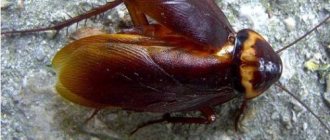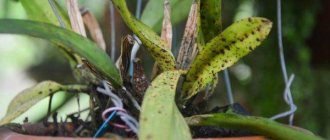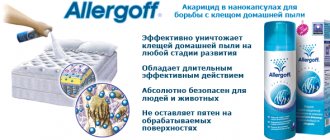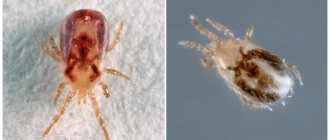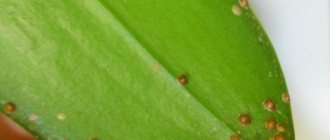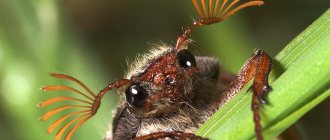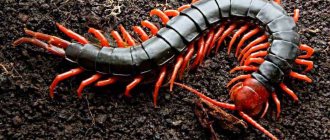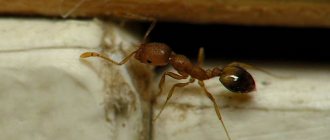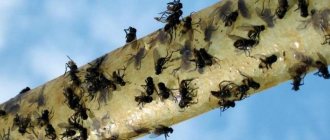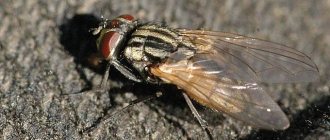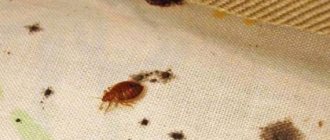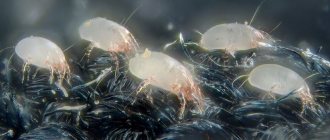- Where do ticks live?
Ticks are not only quite unpleasant and dangerous (especially in the summer) creatures, but also one of the most ancient representatives of the animal world on our planet. They existed long before the appearance of the first dinosaurs, outliving these giant
lizards feel quite at ease in our time; millions of years of evolution have passed for ticks with virtually no changes. Our article today is about them.
Mite: description, structure, characteristics. What does a tick look like?
Many people mistakenly believe that ticks are insects; in fact, they are not. They are part of the order Arachnids.
The body length of a tick rarely reaches 3 mm, on average it ranges from 0.1 to 0.5 mm. Do ticks have wings? Like all arachnids, ticks literally do not have wings at all. But adult ticks have four pairs of legs, and what’s interesting is that juvenile ticks that have not yet reached puberty have only three pairs of legs.
Ticks also lack not only wings, but also eyes, but this is not a problem for them at all; without eyes, ticks are perfectly oriented in space with the help of a developed sensory apparatus. And by the way, thanks to this device, they are also able to smell the scent of their possible victim at a distance of up to 10 meters.
Based on their structure, mites are conventionally divided into leathery mites, which have a fused chest and head, and armored mites, whose head is movably attached to the body. Also, leathery mites breathe through the skin and trachea, while oribati mites have special spiracles.
Danger to humans
House ticks do not bite humans. They have not developed an evolutionary need for this, and therefore neither humans nor any of their pets are interested in ticks.
On a note
Therefore, if the residents of an apartment constantly have bites on their bodies, then you should not suspect dust mites. The culprits here are most likely mosquitoes, bedbugs, fleas, linen lice, or, less likely, pigeon mites (we'll talk about them a little later).
House mites are dangerous because they can cause severe allergic reactions. The main tick allergens are digestive enzymes that facilitate the digestion of skin particles in the digestive tract. Some enzymes are excreted in excrement, and when these waste products dry out and are destroyed, they enter the air, are inhaled by a person and settle on his skin. Due to their high biochemical activity, they act in a complex manner: they irritate the skin itself and the mucous membranes of the respiratory tract, and also stimulate the immune response, causing allergies.
On a note
The diameter of household mite excrement is about 30 microns (0.03 mm). Due to their small size, they can easily be caught in the air when children play, sweep the floor, and then be inhaled by a person.
Often the consequences of regular contact with dust mite excrement are the following diseases:
- Chronic rhinitis (sometimes with allergy symptoms, sometimes without them), accompanied by constant nasal congestion;
- Rhinoconjunctivitis with characteristic allergy symptoms;
- Atopic dermatitis;
- Bronchial asthma.
On a note
Some experts even believe that more than half of the cases of bronchial asthma in the world are associated with an allergy to the secretions of domestic mites.
Itching in the eyes, watery eyes and nasal congestion, worse at home, are one of the signs of the presence of dust mites.
Also strong allergens are particles of chitinous membranes of nymphs shed during molting. Likewise, allergies can arise or intensify in response to contact with the skin of dead mites - there are also a lot of them in dust.
It is also useful to read: How to get rid of dust mites in an apartment
A characteristic feature of all diseases caused by tick-borne allergens is the difficulty of determining their etiology. Without special allergy tests, it is almost impossible to find out that rhinitis or asthma developed precisely after a reaction to mite excrement. And many people do not attach much importance to nasal congestion; they often try to figure out the cause of persistent dermatitis on their own and, of course, cannot do this.
Therein lies a certain danger: often complex and not always harmless means and methods, including surgical intervention, are mistakenly used to treat such diseases. While the true cause of the development of pathology may be literally nearby - for example, in a mattress and pillow.
Where do ticks live?
Almost everywhere, these arachnid creatures live on everything
continents (except perhaps Antarctica) and in all climatic zones. As habitats, many species of ticks prefer wet places near water bodies: thickets near river banks, flooded meadows, forest ravines. Some ticks are able to live both in salt water of seas and oceans, and in fresh rivers and lakes. There are mites that live in houses and apartments, in animal fur (house mites, flour mites, dust mites).
How long do ticks live in an apartment?
After the bite, the parasite continues to transform, lay eggs, and mate. For a tick, the lifespan depends on the conditions where it then ends up. While walking in nature, a person can pick up a parasite and bring it into his home. The pest sits on clothing for several minutes without moving, then begins to look for open areas of the body.
The parasite can also hide in a car during trips through the forest, on vacation, or with the windows not tightly open in the parking lot near the house. A pet can bring them into the apartment. In a situation where the tick falls off the dog on its own, there is a possibility of biting a person in the future. Parasites can be found on the bodies of cats, rodents, and birds. It is easier to detect through the fur when stroking. After suction, the parasite begins to inflate, forming a noticeable tubercle.
Life of a tick
The parasite sits on the human body for about 3 days, when it has had enough, it disappears. At home, the female will be able to lay eggs and live, but the larvae will not appear, since there are no favorable conditions. Without food in an apartment, an adult can live up to 8 months, but this is only if it is not detected. If there are pets in the house - a cat, a dog, they will be the next victims. In this case, at the slightest opportunity, the parasite will return to the wild and continue a prosperous life.
The tick sits on the human body without moving for about 30 minutes, then attaches itself to places where the skin is thinner - the back, shoulders, neck, armpits, arms. As food arrives, the tick swells within a few days to sizes ranging from a few millimeters to 3 cm. When a parasite bite is detected, a person does everything possible to remove the tick.
On a note!
Without a head, the parasite shows signs of life for some time - it moves its legs, tries to crawl, but can no longer live fully. Without a body, if removed incorrectly, the head remains in the body of the victim - human, animal. The likelihood of infection with borreliosis and tick-borne encephalitis increases.
What do ticks eat?
According to their diet, ticks are divided into:
Saprophage mites do not pose a threat; moreover, they also bring benefits, as they participate in the formation of humus.
Blood-sucking ticks are a completely different matter; these parasitic ticks wait for the victim, hiding in ambush on blades of grass and tree branches. Then they quietly jump onto her body, using paws equipped with special suction cups, attach themselves to the victim’s body and slowly drink blood from it. It is interesting that not only various large animals and humans, but also other herbivorous mites or thrips can become victims of ticks.
A tick bite is very dangerous, as they can be carriers of various diseases, especially encephalitis. Despite their unpretentiousness in food (as we wrote above, some ticks can go without it for up to three years), they can be incredibly voracious and can sometimes even increase in weight up to 120 times!
Also, in addition to blood-sucking ticks, there are ticks that feed on plant sap; these ticks sometimes cause great harm to agriculture. There are granary mites that eat flour and grain, ear mites that feed on juice from the ear canals, and subcutaneous mites that feed on the fat found in human hair follicles.
How to get rid of dust mites: acceptable methods
Since dust mites cause discomfort and can provoke severe allergic reactions, every person has a reasonable question - how to get rid of dust mites in an apartment? There are many options for dealing with them, each of which has its own advantages and disadvantages.
Related article: How to properly fill floors in a house
We list the main methods for removing dust mites:
- Ultraviolet radiation or drying things in the sun.
- Exposing to frost or exposure to ultra-low temperatures.
- Wet cleaning using a 20% salt solution. It is recommended to carry out such cleaning at least once a week.
- Frequent change of mattresses, pillows and bed linen. Moreover, it is recommended to wash bed linen at a temperature not lower than 65 degrees.
- It is imperative to store clean bedding in a dry and well-ventilated place.
- Vacuuming and constantly emptying the dust container.
- Airing the apartment at any time of the year.
- If possible, avoid woven tapestries, an abundance of carpets in the apartment, a huge accumulation of upholstered furniture and soft toys.
- Clean using a steam generator, as dust mites do not tolerate high temperatures.
These are the most common methods to get rid of dust mites at home. It is important to understand that expensive chemical tests will not provide more noticeable results. You can't completely get rid of dust mites, but regular cleaning will help keep their numbers to a minimum and get rid of the discomfort that mites cause.
Using sprays to control dust mites
Sometimes traditional methods do not produce results in the fight against dust mites. In this case, special tools designed to eliminate the problem will help. This is another effective way that allows you to answer the question of how to get rid of dust mites.
Modern sprays are developed based on environmentally friendly components. Therefore, they do not harm a person, but at the same time they help to fight the problem perfectly. The products have passed all clinical tests, which confirm the safety of the products and allow their use in apartments where small children live. The variety of acaricidal sprays is great, so each buyer can choose the best option depending on the place of application.
Special sprays instantly neutralize mite allergens. They are applied easily and quickly to any surface. Therefore, the problem of how to get rid of dust mites in the sofa is solved in one fell swoop. The spray is intended for treating upholstered furniture, mattresses, carpets, and any other items used in everyday life. In a short time, the substance completely decomposes biologically and does not harm the environment.
Related article: How to choose a closet for the hallway (30 photos)
But no matter how safe and environmentally friendly such preparations are, when using any chemicals, sprays or additives for high-quality cleaning, be very careful. Do not use them indoors, do not apply them in a thick layer, follow the instructions strictly. If you experience any unpleasant sensations or discomfort, immediately leave the room, leaving it to ventilate. The composition of sprays may contain different elements that can provoke unpleasant side reactions in people. This is especially true for people with allergies.
Do not forget that when spraying soft toys, children's clothes and bedding, you must wash them additionally in hot water.
The benefits of wet cleaning to combat dust mites
Another way to deal with dust mites is wet cleaning. The method is simple and effective. You need to remove dust with a damp cloth as often as possible; it is best to carry out this procedure every day. It wouldn’t hurt to clean not only the furniture and floors, but also wipe down the walls and ceiling.
Pre-treatment with anti-dust mite sprays has an additional effect. In combination with wet cleaning, this will give excellent results.
Wet treatment from time to time will not harm carpets and soft toys. It is beyond the power of any person to carry out such work every day, but once every 3-4 months, make it a rule to beat out the carpets and clean them with special cleaning products. In winter, cleaning carpets and rugs with fresh snow is considered a very effective method.
Traditional methods to combat dust mites
Supporters of simple and natural cleaning methods will definitely ask how to get rid of dust mites using folk remedies. After all, these methods are usually characterized by maximum simplicity and safety for residents. Among the folk methods are wet cleaning with table salt, beating out carpets on the street, cleaning carpets with snow and frequently changing bed linen. Do not forget to ventilate and beat mattresses well, because the problem of how to get rid of dust mites in a mattress always raises a lot of questions.
A high-quality air purifier helps clean the air from dust and mites. But it is important to remember that most ticks do not live in the air, but in beds and upholstery. Therefore, an air purification system is a good addition, but not the main method of protection.
Related article: Crafts from autumn leaves
Do not forget to change the air purifier filters every 3-4 months, as they quickly become dirty and cannot do their job efficiently.
Maintain indoor humidity no more than 30-50% and air temperature no more than 25 degrees. A damp and warm environment is ideal for ticks to breed, which is what we try to avoid.
In simple terms, regular and thorough cleaning will rid the room of the presence of dust mites. High-quality cleaning, constant change of linen and cleaning of toys will help create conditions in the apartment that are unfavorable for the life and reproduction of dust mites. This is the best thing you can do to combat parasites.
Types of ticks, photos and names
The zoological classification of ticks includes more than 4,000 species, which scientists have roughly divided into three groups:
- parasitomorphic (this includes gamasid, argasid, nuttalium, ixodid ticks).
- acariform (scabies, hair, feather, marine, freshwater, thyroglyphoid, acaridia, oribatiform, sarcoptiform, thrombidiform mites).
- Haymaking mites are classified into the third group.
Below we describe some interesting types of ticks.
Ixodid ticks
The body of these ticks is covered with hard chitinous plates and has quite impressive dimensions for ticks - they reach 2.5 cm in length. These ticks live in temperate latitudes, almost throughout Eurasia. Waiting in the foliage and various bushes for their victims, they parasitize many forest and domestic animals, including humans. Having clung to the skin of its victim, the ixodid tick is able to drink blood from several days to two to three weeks.
Argasid mites
These mites, which live in the cracks of houses and outbuildings, parasitize domestic animals and birds, preferring chickens most of all. They can also attack humans. The bite of an argas tick is very painful, accompanied by severe itching and a rash at the site of the lesion. It lives over a wide geographical range, almost throughout Eurasia.
Armored mites
These mites mainly live in the soil, although there are subspecies among them that prefer to live in trees. Also, oribatid mites are not predatory parasites; their food source is mushrooms, lichens and other plant debris. Despite this, the oribatid tick poses some danger to other animals, as it is a carrier of helminths and tapeworms.
Gamasid mites
These mites live in the nests of birds, as well as in the burrows of rodents, mice and rats, and for good reason, because they parasitize on them. Gamasid mites cause great harm to poultry farms, as they love to parasitize chickens, causing them to lose feathers and have huge scratches on their skin.
Subcutaneous mite
This mite is especially insidious, since, crawling under the skin of both humans and animals, it can remain unnoticed for a long time, causing itching and irritation in the affected area.
Scabies mite
This mite is also very unpleasant; it is the mite that causes scabies in humans and animals by making small passages in the skin. It feeds not on blood, but on skin secretions, causing severe itching and redness.
Ear mite
Ear mites cause the most trouble to beloved human pets -
For cats and dogs, their ears are where their food comes from. This tick is safe for humans, but animals have a hard time with it. To remove it, cat and dog owners often have to contact veterinarians.
Dust mite
Dust mites are not parasites; they feed mainly on accumulated dust, fluff and feathers. Therefore, it is sometimes also called bed or linen flare.
Spider mite
This tick is completely harmless, as it is a true vegetarian among ticks, feeding exclusively on plant juices. It is also a carrier of a disease that is dangerous for many plants - gray rot.
Water mite
It is also a sea mite, it lives either in flowing fresh water bodies, and some subspecies also love salty sea water. They parasitize shellfish and some aquatic insects.
Predatory mite
This is a real cannibal tick, as it feeds on its relatives, other ticks. For this reason, it is sometimes specially planted by people in greenhouses and gardens to combat spider mites that are harmful to plants.
Pasture mite
This tick usually lives in forests and forest-steppes. It is dangerous for both humans and animals, as it is a carrier of encephalitis, plague, and fever.
Brown dog tick
It is safe for humans, but not for dogs.
Types of house ticks
Several species can simultaneously live in a person’s apartment, each of which has its own location. Some species can be blood-sucking, others feed on dead cells, and still others parasitize houseplants and animals. But there are also more dangerous representatives of this class, which do not just attack a person, but settle on the body, under the skin or in the ears.
Dusty
Dust mites are the most common neighbors of humans and can be found in almost every apartment. This species cannot be noticed by the human eye, but if the parasite population exceeds acceptable standards, this can have an extremely negative impact on health, especially for young children. These mites feel most comfortable at a humidity of 50% and a temperature of 18 to 25 degrees, which is most often room temperature.
The favorite locations of dust mites are books, soft toys, sofas, bedding, carpets and absolutely any surface on which a large amount of dust accumulates.
Such parasites feed on dead skin cells and do not have direct contact with the human body, which does not make them any less dangerous. The greatest threat is posed by the waste products of the parasite, which accumulate in a person’s home every day. They are one of the most powerful allergens and easily penetrate the respiratory tract. The consequence of a large accumulation of dust mites is allergic rhinitis, asthma, dermatitis, conjunctivitis and even angioedema.
Ixodes
Ticks of this species are one of the largest representatives of the class and are found on absolutely any continent and in any climatic zone. Such parasites are not permanent residents of apartments or houses, but very often get there with the help of pets or on clothing. Parasites are blood-sucking and easily find a future victim. Ixodid ticks are most active from May to September; when returning from a walk during these months, it is necessary to carefully inspect the clothing and fur of your pet. The most terrible consequences are considered to be encephalitis, borrelosis and Lyme disease. If an ixodid tick bite is detected, you should not only remove the parasite, but also take it for analysis to the nearest laboratory.
Arachnoid
If a spider mite has settled in an apartment, the first place to look for it is a windowsill with house plants. This parasite, contrary to the erroneous belief, is not an insect, but an animal and is constantly in search of food. It may appear with a new purchased plant or sneak through an open window. This species attacks the plant quite quickly and easily moves onto healthy flowers. It does not pose any direct harm to humans, but may not destroy all home greens.
Bed
This type of mite is often found in a person’s apartment; it can be found on upholstered furniture, mattresses, bedding and soft toys. The parasite does not exceed 1 mm in size, but it is unlikely that you will be able to miss the appearance of such a neighbor. The peak activity of bed ticks occurs at night; it is in the dark that they are easiest to detect. The parasite is blood-sucking and leaves behind many bites on the body, close to each other. Bed mites are responsible for allergic reactions in humans, rashes, redness of the eyelids and cause bouts of coughing or runny nose without additional symptoms of ARVI.
Tick eggs
In the spring or late summer, having had enough of the blood of its victims, the fertile female tick makes a clutch consisting of 2.5-3 yew. eggs What do tick eggs look like? They are a very large cell, which consists of a nucleus and
cytoplasm, also covered with a two-layer membrane of different colors. Tick eggs come in a variety of shapes, from oval to square, flattened and elongated.
Where do dust mites come from?
The tiny house dust mite entered the human home thousands of years ago with bird fluff and animal fur; it is easily carried with food particles, clothing, shoes, and pets. Microscopic organisms find refuge in bedding, books, soft toys, carpets, folds of upholstery, and in crevices under baseboards. Dust mites love room temperatures ranging from 18-25°C with a humidity of 55%.
Dust mites in mattress
You can almost always find house dust mites in our mattresses. This is explained by the optimal conditions for life that are created in a human bed. Under the blankets there is always a stable temperature and percentage of humidity; here, most of all, there are remnants of dead skin particles - the favorite food of small parasites.
Dust mites in pillows
Horny pieces of epidermis accumulate in large quantities in pillows consisting of soft fabric and bird feathers, so dust mites often create huge colonies in beds. Knocking out and processing in autoclaves will not completely destroy these dangerous neighbors. Experts recommend that people prone to allergies replace pillows with down and feathers with bedding consisting of hypoallergenic and antibacterial materials - bamboo fiber, microgel, holofiber.
Tick larva. Are tick larvae dangerous for humans?
What does a tick larva look like? Having hatched from the egg after 2-4 weeks, the larva is, in fact, an advanced copy of its parents. It does not exceed 0.5 mm in size and we can say that the larva looks like a small poppy seed. Also, as we wrote above, it has only three pairs of legs, and not four, like in adult ticks.
The body of the mite larva is not yet fully formed, there are no bristles yet, and in oribatid mites the body shell is still thin. Just like adult ticks, larvae hunt, only they choose small terrestrial animals as victims:
hedgehogs, mice, lizards (it is still difficult for them to rise to great heights).
As for the danger of tick larvae for humans, yes, the larvae are just as dangerous as adult ticks, because they can also carry the same encephalitis and other unpleasant diseases.
What it is?
Definition
House ticks belong to the type of sinatropic mites, that is, they are closely related to humans and their homes, just like mice, cockroaches, bed bugs, etc. At this time, microbiologists have established that there are more than 150 species of these parasites. And more than 10 species can cause an allergic reaction in humans.
The size of these parasites is so small that it is impossible to see them without a microscope. But their number in our house is huge - up to a thousand in just 1 g of dust, and up to hundreds of millions on our bed.
The peculiarity of dust mites is that they cause allergies. Feels good in carpets, feather pillows, mattresses, sofas, bed linen, etc.
All this is located approximately 1 meter from the floor and, when it enters the body, it provokes allergies. If the concentration of dust mites exceeds the norm, asthma may occur.
The dust mite feeds on dead skin particles, which a person loses, as is known, every day, in the amount of 1.5 - 2 g.
The mites themselves leave behind traces - feces, which destroy human skin and are very dangerous because they cause severe allergies.
REFERENCE! Each tick releases up to 20 fecal pellets per day. That is, only 1 mite produces 200% more waste than its own weight!
German scientists from the University of Munich have long proven that in children who live in villages and suburbs, allergies are much less common due to early contact with pets than in residents of cities and large cities who live in relatively sterile conditions, far from living things. nature.
How do they look?
Dust mites belong to the family of arachnids of the arthropod class. Very small, no more than 0.5 mm in size. Not noticeable to the naked eye, they are dangerous to humans and cause asthma and other allergic reactions.
Dust parasites live only 2-3 months, but how much harm and real danger each of them brings! The female can lay 50–60 eggs at a time.
Dust mites thrive in damp rooms, in apartments with high humidity and musty air. They like to live at temperatures from 19 to 25 °C, with air humidity above 55 - 60%.
What dust mites look like and how to recognize them is discussed here.
Existing types
Dust mites are conventionally divided into three types:
- Pyroglyphid (dermatophagoid: for example d farinae and d pteronyssinus) and some representatives of granary mites that appear from house dust.
- Predators are mites that feed on pyroglyphid mites.
- Random ticks brought in from outside and not reproducing in the apartment.
Tick nymph. Is a tick nymph dangerous?
Having eaten someone else's blood, the tick larva eventually turns into a nymph. The latter has larger dimensions (1-2 mm) and already has four limbs. As a result, the tick nymph can choose larger animals as objects for parasitism, and even attack humans.
Just like adult ticks, nymphs are carriers of various infections, and therefore dangerous.
Tick bite and diseases
A tick bite is not only unpleasant in itself, as it is accompanied by itching, burning, redness of the skin at the site of the lesion, but its main danger is that various diseases and infections can be transmitted with it, including:
- Lyme borreliosis
- tick-borne encephalitis
- epilepsy and hyperkinesis
- arthritis
- nephritis
- indigestion
- pneumonia or pulmonary hemorrhage
- arterial surges
pressure and arrhythmia
What does a tick bite look like? Like this.
What should I do if bitten by a tick? First aid for a tick bite.
First of all, you need to remember that a bitten tick should not be crushed under any circumstances; it must be removed from the skin as quickly as possible, and completely. To do this, you can use one of the following methods:
- Generously lubricate the part of the tick's body sticking out with vegetable oil or wait 3-5 minutes. The fact is that the tick's respiratory organs are located in the back of its body, so while suffocating, it will try to get out.
- You can try to lubricate the tick with kerosene, after which after 10 minutes it will either unhook itself, or loosen its grip, after which it can be carefully pulled out with tweezers.
Now you know how to remove a tick.
It is extremely important to save the removed tick (you can put it in a plastic bag) in order to conduct laboratory tests and determine whether it was an encephalitis tick or not. Of course, both the severity of further consequences of a tick bite and future treatment depend on this.
After a tick bite, you should definitely consult a doctor.
How dangerous are ticks?
Many people remember stories from childhood when they were bitten by a tick and simply got it out. In this regard, not everyone knows that they are very lucky. If you catch a tick, this is not only an annoying incident, but also deadly. The tick crawls under the skin and sucks blood. Which, at best, leads to itching and burning, and at worst, fatal diseases: borreliosis, encephalitis, spotted fever, relapsing fever, epilepsy, pneumonia, paralysis and others. The symptoms of diseases in the initial stages are, by and large, no different from ordinary diseases or bites of numerous other representatives of fauna: fever, redness of the bitten area, itching and burning, chills, aches, swelling. Sometimes the bite is accompanied by headaches, nausea and even hallucinations. Therefore, after each visit to their suspected habitats, inspect the body for bites.
Do not go into the forest in open clothes and protect yourself with various repellents, of which there are a huge number on store shelves now. If you often relax in nature, then it is better to go for vaccinations carried out in medical institutions.
If it happens that a tick does bite you, then it is best to consult a doctor immediately. If this is not possible, then you can try to get it yourself. This must be done as carefully as possible; the body of the tick is easily separated from the head, and if it remains, it is much more difficult to remove on your own. Ticks are removed using thread or tweezers. Using gentle circular movements, smoothly remove the carcass. Make sure the head comes out exactly.
Under no circumstances should you throw the tick away after this. It must be taken to a research laboratory to check whether it is encephalitic. If you have been bitten by just such a tick, then you need to see a doctor to prescribe therapy. If a person is paralyzed after a tick bite, you must immediately call an ambulance. You cannot take any independent action.
Tick protection for humans
The most effective means of protection against ticks are repellents - special sprays for children and adults that are applied to outer clothing and repel ticks.
You can also try folk remedies against ticks:
- Ticks do not like the smell of geranium and lavender; you can put bushes of these plants in your pockets when going into the forest.
- Intensely scented essential oils can also untangle ticks.
Interesting facts about ticks
- The smallest tick in the world, measuring only 0.08 mm in length, is even listed in the Guinness Book of Records.
- Three adult ticks, if placed together, will look like the dot at the end of a sentence in size.
- At birth, not a single tick is a carrier of dangerous infections; they only acquire them after parasitism.
- A female ixodid tick can eat 100 times more food than a male. After such a hearty meal, the female can increase in size by 150 times.
Links and useful literature on the topic
- Zhang, Z.-Q. et al. "Phylum Arthropoda von Siebold, 1848". — In: Zhang, Z.-Q. (Ed.) “Animal biodiversity: An outline of higher-level classification and survey of taxonomic richness.” (English) // Zootaxa / Zhang, Z.-Q. (Chief Editor & Founder). - Auckland: Magnolia Press, 2011. - Vol. 3148. - P. 99-103. — ISBN 978-1-86977-849-1 (paperback) ISBN 978-1-86977-850-7 (online edition).
- Günther Schmidt. Giftige und gefährliche Spinnentiere: []. - Westarp Wissenschaften, 1993. - P. 58ff. — ISBN 3-89432-405-8.
- A Manual of Acarology / Gerald W. Krantz & DE Walter. - 3rd. - Texas Tech University Press, 2009. - ISBN 978-0-89672-620-8.
- S. C. BARKER and A. MURRELL (2004). Systematics and evolution of ticks with a list of valid genus and species names. Parasitology, 129, pp. S15-S36. DOI:10.1017/S0031182004005207.
- Harvey MS (2002). The neglected cousins: what do we know about the smaller arachnid orders? Journal of Arachnology, vol. 30, pp. 357-372. pdf Archived February 7, 2012. (English)
